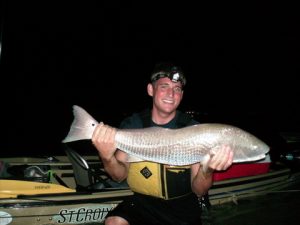
By Neil W. Taylor, strikethreekayakfishing.com
“I don’t go fishing at night. Should I be fishing after dark?”
It is a part of the day mostly neglected by anglers. Honestly, if you like fishing without other people around, this is the way to achieve it. Nighttime trips are very enjoyable for a variety of reasons. You should feel comfortable giving it a try after you read what I have to say about it.
Nighttime is one of the best times to target this nocturnal species. The species adjust to seasonal conditions and logic has it, the coolest the water will be will be at night, close to sunrise. The most comfortable time to go, nighttime. An opportunity basically neglected, should you be doing more fishing at night? Are there certain times of the month that are better than others?
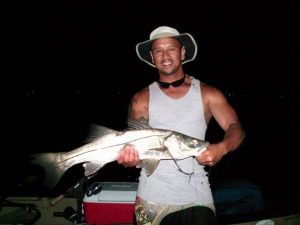 With summertime just ahead, nighttime is a great time to catch snook, redfish and speckled trout. The very hot water, June through mid-October: Fish after the storms. Fish first light/last light: My six to ten rule, you should think about fishing your daytime trips 6 to 10AM or 6 to 10PM. But don’t forget that there are incredible opportunities well after dark. To answer the question above: Fishing nighttime around the full moon is usually more productive than other times. But there are great opportunities around the new moon as well. Like daytime action, the full and new moons translate to better moving water.
With summertime just ahead, nighttime is a great time to catch snook, redfish and speckled trout. The very hot water, June through mid-October: Fish after the storms. Fish first light/last light: My six to ten rule, you should think about fishing your daytime trips 6 to 10AM or 6 to 10PM. But don’t forget that there are incredible opportunities well after dark. To answer the question above: Fishing nighttime around the full moon is usually more productive than other times. But there are great opportunities around the new moon as well. Like daytime action, the full and new moons translate to better moving water.
I take a lot of people night fishing to give them the first experience. People are timid about going at night. It is just like when you were a kid and scared of monsters in the closet: “There isn’t anything there that isn’t there in the daytime.” But you do need to be more careful than on trips when visibility is much better.
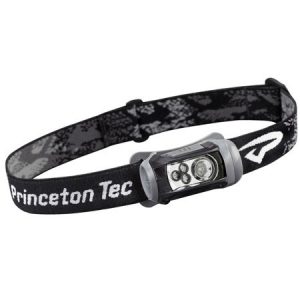 Lights: Keep a headlamp readily available to help with tying knots, landing a fish. Keep a larger light available for signaling boats of your presence. A 360 degree light is a great investment and a requirement if you plan to put your boat on anchor and wade. Spare batteries and an extra flashlight can be kept in a dry bag and stored in your kayak. Other lighting is required for power boats with bow and stern lights necessary.
Lights: Keep a headlamp readily available to help with tying knots, landing a fish. Keep a larger light available for signaling boats of your presence. A 360 degree light is a great investment and a requirement if you plan to put your boat on anchor and wade. Spare batteries and an extra flashlight can be kept in a dry bag and stored in your kayak. Other lighting is required for power boats with bow and stern lights necessary.
Success is achieved by adjusting your tackle and good decisions in targeting.
There are five basic situations for fishing the summertime months
- The Beach- “swash” fishing
- The Pass- Deep water efforts
- The Ambush- shallow grass and sand areas with good current.
- The Flats
- Docks and Bridges
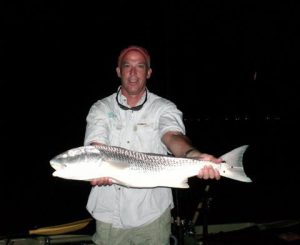
Digital image
Deep-water efforts.
This would be the “Pass” fishing for snook. Tackle changes will often require heavier lures for the deeper water combined with the moving currents. “Learn” where the fish seem to be caught at a particular stage of the tide. In the Pass situation often you don’t have the “clues” you have in the other two situations (the Beach, and the shallower water Ambush situations). Get your lures down near the bottom.
The Beach
Out front there are opportunities day and night. The fish will spend a lot of time in these areas in the nighttime hours.
The Flats
The fish are available in the shallows where you find them in daytime efforts. The more moonlight, the better this action will be. Honestly, I think live or other natural baits work better in this scenario. All the other scenarios, I just use the lures.
Docks and Bridges
One of the most popular places for nighttime action, docks and bridges create more opportunities than other locations, especially if there are lights on the structures. This is often a scenario with slightly less visibility issues.
The Ambush:
Existing in pretty much all the other scenarios, this is where fish lie in wait for something to come to them. Current is a common theme in ambush scenarios. If you know where a predator is, you can put your bait in the ambush zone and connect.
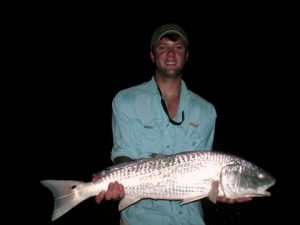
Use appropriate sized tackle. Regular tackle works fine for most scenarios, heavier rods and tackle are required for dock and bridge fishing. Dock and bridge fishing is the #1 single reason to own some tough rods. You won’t stand a chance with trout gear. You have to be able to move the fish from the structure.
Can you find it?
Can you find a location at night? Waypoints can be tough after dark. A GPS is helpful if you don’t have another landmark (i.e.: point of an island, end of a sandbar) Some places it is pretty easy. Others it may take several attempts. Make no mistake, it is the same as daytime fishing: Being in exact spots pays off.
Hiding the hook
Floating weeds/grass are a constant during the rainy season. It can be a nightmare to use a conventional jighead in these situations, treble hook lures even worse. Your options: Powerlock, Captain Joe Hebert’s “Edje” jighead. Texas rigged SlamR. If you don’t own this tool, make the investment. 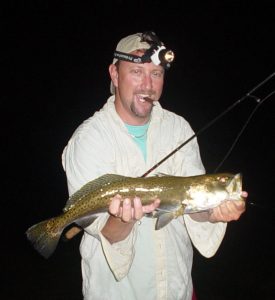
Colors Lure color is not as important in daytime fishing. Specific choices are better for nighttime outings. What would I recommend for the Tampa Bay area? Pink silver glitter, silk chartreuse (after sunset), pearl white (sundown) and black are good after dark color options.
Listen, Look and Learn. Listen: You will hear violent splashes, evidence of feeding fish.
Look- 8 to 10 inch mullet pushed up in to tight balled up schools are often corralled that way by a school of approaching fish.
Learn- study what tide you found those fish in that particular location and return there on similar tides on future trips.
Putting in your time:
The fish aren’t on the feed all the time, even during the best of tides. With experience you will become more astute at “guessing” when the fish will be in feed mode. It doesn’t always hold true. If you see all the ingredients (a good tide, low light conditions, presence of large schools of baitfish, presence of medium size mullet, a solunar major or minor) it should just be a matter of time until the fish go into a feed mode.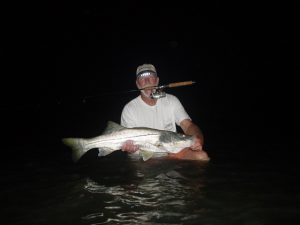
Making adjustments:
Presentation of lures is key”. They will pick up lures that are still on the bottom if they resemble a shrimp of a baitfish. If you know you are into an area where the feed is on, but you’re not hooking up: Change up the retrieve style. When the lure enters an area where the baitfish are nervous, add some action to the lure in that situation to elicit a strike. If you still don’t get a strike trying the various techniques, try another lure or another color.
#1 Safety Tip If you remember nothing else from this article, take this one away from it- For fishing at night, wear some Eye protection, even if it is safety goggles. You lose the sight of objects moving toward you. When a lure comes off a snag or out of a fish’ mouth, often it is come directly at you. Better to have it deflect off protective eyewear than to take a direct hit to your eyeball. It’s going to happen. And you are going to thank me.
On Safety #2 Lighting and storms are possible at any time in Florida but very likely in the summer months. Check the forecast and radar before you go but have someone you can call to get updates if you see any changes in the weather. Should there be lightning in the area, seek shelter and lay all your rods down in the kayak. The one rod I left up in a storm where I beached and hunkered down on an island was struck by lightning.
On Safety #3 It is generally a good idea to do night fishing trips in areas that you know very well from your daytime outings. Exploring a new area, probably not your best choice on a nighttime fishing trip.
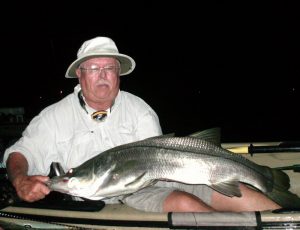
Just a reminder on “Fish Handling Tips”
Sand dragging a fish quite plainly is extremely harmful to the fish. A snook can be secured with your thumb and forefinger or a gripping tool. In most of the pictures you will see of clients with snook they are out of their kayaks. The fish is kept in the water until it is time for the fish to be lifted up for a quick photograph. For all fish that are being released, minimize the time they are out of the water and give the fish appropriate support when lifting for the photo. With the second hand supporting the belly of the fish, it can be lifted up horizontally without stressing the jaw or the internal organs of the fish. Every step you take that eases the stress on the fish, increases the chance that the fish will survive post-release predation.
Getting a “weight” of a fish is damaging to the jaw of the fish. Mathematical formulas exist to estimate the weight of your fish. Getting a great estimation is way better than decreasing the odds that fish survived the encounter. Our biggest fish are our most important fish.
If good handling of the fish is used, revival isn’t always necessary. Should a fish require some extra attention, hold the fish facing in to the current and gently move the fish so that water is going in its mouth and through the gills. Watch the fish after you let it go and make sure it swims off. If it lingers, secure the fish again by the lip and repeat the revival technique.
Go try it, do it safely. Nighttime trips can provide outstanding results. Nighttime trips are extremely enjoyable, especially when things are so dreadfully hot in the middle of summer.
Neil Taylor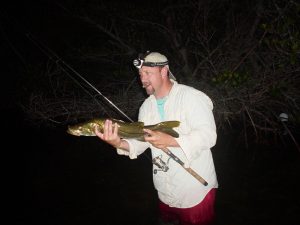
Owner and guide: www.strikethreekayakfishing.com
(Cell) 727-692-6345 LivelyBaits@aol.com
Owner and site administrator: www.capmel.com
Co-host: “Capmel.com Radio”, 8 to 9AM Sundays on 1040 “The Team” Radio
- The Neil Blog… - July 26, 2023
- The Catfish - July 26, 2023
- update - July 22, 2023











